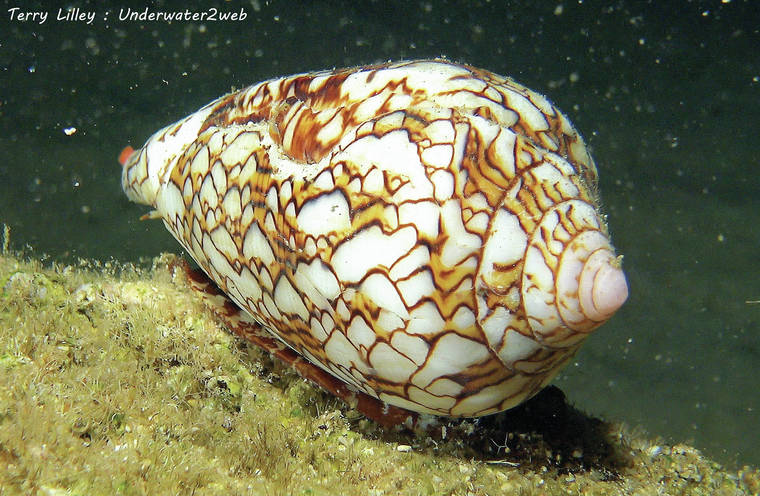Thousands of people here in Hawai‘i and around the world wear this shell around their neck, but few people have ever seen a live textile cone shell. The famous puka shells are made by the large surf when a cone shell dies and gets ground up in the waves and the only thing that remains is the top, flat part of the shell. These ground-up cone shells often roll around on the reef and fall into “pukas,” which are holes in the reef, and then are collected by jewelry-makers and strung together to make the famous puka-shell necklace.
Thousands of people here in Hawai‘i and around the world wear this shell around their neck, but few people have ever seen a live textile cone shell. The famous puka shells are made by the large surf when a cone shell dies and gets ground up in the waves and the only thing that remains is the top, flat part of the shell. These ground-up cone shells often roll around on the reef and fall into “pukas,” which are holes in the reef, and then are collected by jewelry-makers and strung together to make the famous puka-shell necklace.
It is best to only pick up the dead cone shells off of the beach because a live textile cone shell is highly venomous and has been known to kill people. Dozens of people a year here in Hawai‘i are rushed to the hospital after grabbing a live cone shell off of the reef and being stung by it. These shells are extremely beautiful and valued by shell collectors, and can be found in shallow tide pools where they prey on other types of marine snails. The cone shell will flip over a beautiful cowry shell and sting it with its deadly proboscis that is tipped with a venomous, harpoon-like tooth. Once the cowry shell soft body is paralyzed by the venom, the cone shell protrudes its long mouth into the cowry shell to consume it.
Collectors find a large amount of puka shells on Hawaiian beaches, especially on the North Shore, where the giant winter surf grinds up the shells along with the coral which makes the beautiful white sandy beaches. But divers rarely see the live cone shells out on the reef because they often live under the sand. Most of the live textile cone shells I have seen were when I was out night diving, when they come out of the sand and crawl about the reef looking for food. The cone shells are a marine snail, and they move very much like the land snails you see in your garden. But their shell is much thicker to withstand the pounding of the large surf.
The Hawaiians in the past were well aware of the stinging ability of the cone shells, as their Hawaiian name means “dizzy shells” due to how you felt if you were foolish enough to get stung by one.
You can see pupu poniuniu in action in the movie “The World’s Guide To Hawaiian Reef Creatures” on the educational web page underwater2web.com, and also have your children see the cone shells in the sea at the nonprofit Coral Reef Summer Kids Camp with Reef Guardians Hawai‘i run on Kaua‘i. Also, follow the underwater educational series on the Facebook page under my name Terry Lilley.
Aloha from under the surf.
•••
Terry Lilley, a marine biologist, lives in Hanalei. His websites include underwater-2web.com and www.gofundme.com/5urrm4zw.

Subscribe today for unlimited access.
Already a subscriber?
Login
Not ready to subscribe?
Register for limited access.
If you have a print subscription but require digital access,
activate your account.





Death by Conus textile stings has been the result of three factors: 1) the victim developed a secondary infection at the injury site, most likely from staphylococcus bacteria; 2) the victim had an underlying condition making them hyper sensitive to the venom; and 3) a case of mistaken identity: many records of injury and death attributed to Conus textile were in fact from Conus geographus, that in the younger stages of growth, the shell has a superficial resemblance to that of Conus textile. That being said, Conus geographus does not inhabit the waters around Hawaii – the closest it gets are the Marquesas Islands and Tuamotu Atolls of French Polynesia. Conus textile stings have occurred in Hawaii, but all victims recovered.